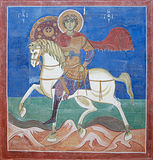 Apostles of the Seventy Erastus, Olympas, Herodion, Sosipater, Quartus, and Tertius (Terence) (1st c.).
Apostles of the Seventy Erastus, Olympas, Herodion, Sosipater, Quartus, and Tertius (Terence) (1st c.).
Commemoration of the beginning of the torture of Great-martyr George (303). Martyr Orestes the Physician, of Cappadocia (304). Hieromartyr Milos (Miles), bishop in Persia, and his disciples, Martyrs Aborsam and Senoe (ca. 341). Great-martyr Constantine-Kakhi, prince of Kartli, Georgia (852). St. Theocteristus, abbot, of Symbola Monastery on Mt. Olympus in Bithynia. Glorification of St. Matthew, monk, of Yaransk (1997).
New Hieromartyrs Procopius (Titov), archbishop of Kherson, and Seraphim (Gushchin), hieromonk of Optina Monastery (1931). New Hieromartyrs Augustine (Belyaev), archbishop of Kaluga, and with him Ioannicius (Dmitriev), archimandrite, of the St. George Monastery (Meshchevsk), Niphon (Vyblov), hieromonk, of Berezovy Khutor (Saratov), and John Speransky, archpriest, of Kaluga (1937). New Martyrs Alexis Gorbachev, Apollonius Babichev. and Michael Arefeyev, Nicholas Smirnov, Anna Ostroglazova (1937-1939). New Martirs Olga Maslennikova (1941) and Theoctista Chentsova (1942).
St. Eucharius, first bishop of Trier (3rd c.). St. Nonnus, bishop of Heliopolis (471). St. Justus, archbishop of Canterbury (627- 631). Ten Martyrs of Gaza, at Jerusalem: Callinius, Imerius, Diasimus, Theodore, Stephen, Peter, Paul, Theodore, John, and John (638). Translation of the relics of St. Gregory, bishop of Assos near Ephesus (1150).
Thursday. [II Thess. 2:13-3:5; Luke 13:1-9]
Pilate mingled the blood of Galileans
with their sacrifices—the Lord said: except ye
repent, ye shall all likewise perish; the tower of
Siloam fell and killed 18 people—the Lord again
said: except ye repent, ye shall all likewise
perish. This gives an understanding that when some
misfortune befalls others, we must not reason about why it
happened, but rather look at ourselves and examine whether
there are any sins on us deserving temporary punishment
for the instruction of others, and hasten to wipe them out
with repentance. Repentance cleanses sin and removes the
cause which attracts a catastrophe. While a person is in
sin, an axe is laid to the root of the tree of his life,
ready to cut it down. It does not cut because it waits for
repentance. Repent and the axe will be taken away, and
your life will flow to its end in the natural order of
things; if you do not repent—expect to be cut down.
What man can know whether he will live to the next year?
The parable about the fruitless fig tree shows that the
Saviour prays that Divine justice spare each sinner in the
hopes that he will repent and bring forth good fruits. But
it sometimes happens that Divine justice no longer hears
the intercessions, and perhaps He will only agree to allow
somebody one more year to remain alive. How do you know,
sinner, that you are not living your last year, your last
month, day and hour?


![]() Apostles of the Seventy Erastus, Olympas, Herodion, Sosipater, Quartus, and Tertius (Terence) (1st c.).
Apostles of the Seventy Erastus, Olympas, Herodion, Sosipater, Quartus, and Tertius (Terence) (1st c.). 













